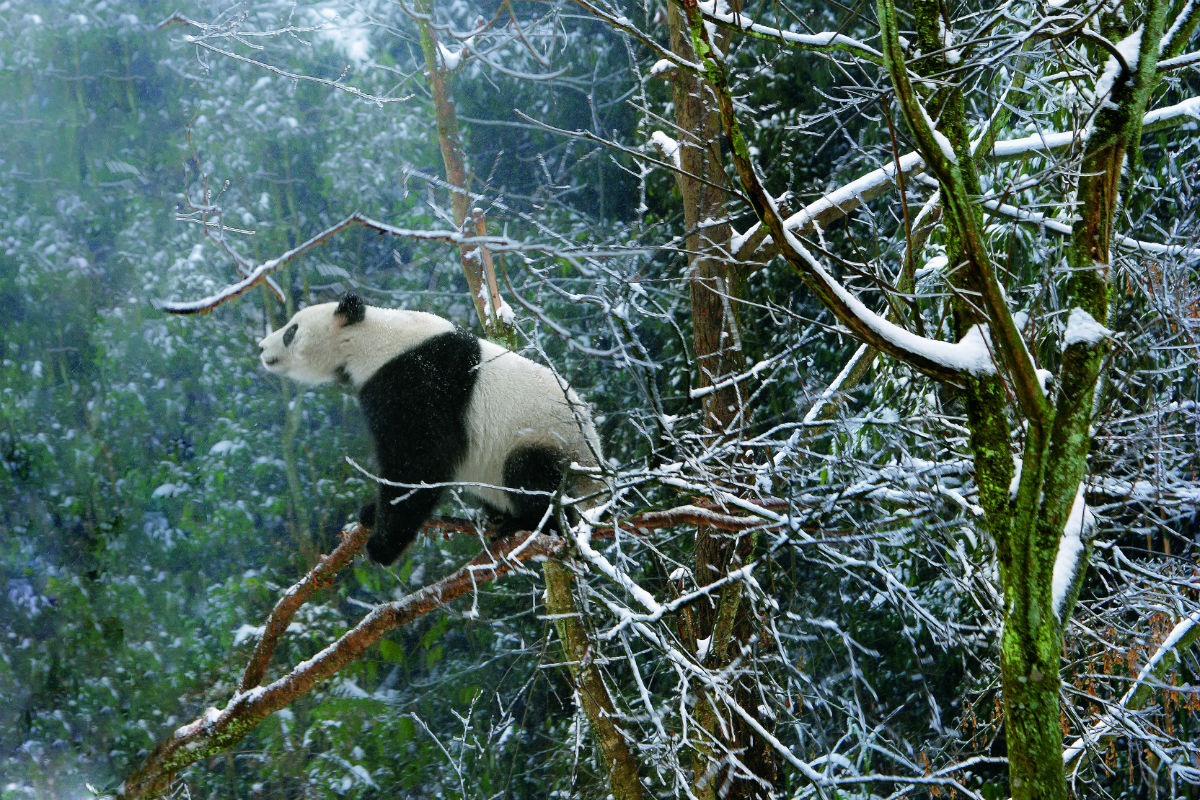Giant Pandas by the Numbers

Overview of Giant Pandas
As of the end of 2013, 1,864 giant pandas were living in the wild in China. The southwestern province of Sichuan, home to most of the country’s wild pandas, counted a total of 1,387, 74.4 percent of the total in China. Neighboring Shaanxi and Gansu provinces tallied 345 and 132, respectively.
As of November 2018, the count of captive pandas had reached 548 worldwide, of which 482 were in Sichuan Province.
Giant pandas live in a few mountain ranges including the Qinling, Minshan, Qionglai, Daxiangling, Xiaoxiangling, Daliang and Xiaoliang mountains, covering 17 cities (prefectures), 49 counties (county-level cities and districts) and 196 townships in Sichuan, Shaanxi and Gansu provinces.
By the end of 2013, the total area of wild giant panda habitats had reached 2.58 million hectares, with potential habitats totaling 910,000 hectares.
Nationwide Giant Panda Census
To ensure accurate data on wild giant pandas, the Chinese government carried out national surveys from 1974 to 1977, 1985 to 1988, 2000 to 2004 and 2011 to 2014. The surveys indicated a panda population of 2,459, 1,114, 1,596 and 1,864, respectively, showing the number of wild giant pandas in China declining first and then increasing slowly. In the fourth survey, DNA analysis was first utilized to identify the gender of pandas and evaluate the genetic diversity of wild pandas.
Living Habits
The primary daily activities of a wild giant panda are eating and resting. The animal spends almost half of the day resting, with a single rest of about two to three hours.
Giant pandas are known to eat more than 50 kinds of bamboo, of which around 20 kinds are preferred. A panda needs to eat 10 to 20 kilograms of bamboo per day.
Wild female giant pandas normally have a cub once every two years and ovulation lasts from several days to more than 10 days. When a female is in heat, at least two to three males, sometimes up to six or seven, fight fiercely for mating rights.
Panda cubs usually live with their mothers until they are one and a half years old (some up to two and a half years old) and then start living alone.
Panda Conservation in China
By the end of 2013, China had established 67 nature reserves with giant panda habitats and potential habitats, 58 of which had detected giant pandas.
A total of 1,246 wild giant pandas live in these nature reserves, accounting for 66.8 percent of the total population in China. The habitat area of giant pandas in nature reserves is about 1.39 million hectares, accounting for 53.8 percent of the total area in China.
National nature reserves of China play a key role in panda conservation by maintaining relatively high population and density compared to other areas.
Into the Wild
On August 8, 2005, a wild giant panda named Shenglin I was freed into the Longxi-Hongkou National Nature Reserve in Sichuan Province, a habitat for wild pandas, and researchers began to track and monitor her activity in the wild.
On April 28, 2006, a giant panda named Xiangxiang was released into the wild in the Wolong National Nature Reserve in Sichuan Province, the first captive-born giant panda to be released in China.
From 2009 to 2013, a wild giant panda named Luxin and three captive giant pandas—Tao Tao, Zhang Xiang and Xue Xue—were released one by one in the Liziping National Nature Reserve of Sichuan Province.
On October 21, 2016, two captive giant pandas, Hua Yan and Zhang Meng, were released into the wild, the first time a pair of pandas were sent into the wild together.
On November 23, 2017, two captive giant pandas, Baxi and Yingxue, were released into the Liziping National Nature Reserve, the first time two pandas of different genders were sent into the wild together.
On December 27, 2018, two captive giant pandas, Qinxin and Xiaohetao, were released into the Longxi-Hongkou National Nature Reserve in Sichuan Province.
Challenges in Protection
Wild giant pandas in some regions still face substantial risk. According to the results of the fourth national giant panda survey, the wild giant panda population is divided into 33 subpopulations, some of which number fewer than 30.
Among them, 24 subpopulations faced “high risk of collapse,” affecting 223 giant pandas, 12 percent of the total population in the wild, especially the 18 subpopulations with fewer than 10 pandas each.
Severely fragmented natural habitats also threaten giant pandas. By the end of 2013, 319 hydroelectric dams, 1,339 kilometers of roads and 268.7 kilometers of high-voltage transmission lines had been built in giant panda habitats around China. Human activities have further aggravated habitat fragmentation.
International Cooperation
As of November 2018, China had carried out panda conservation and research cooperation projects with 22 zoos in 17 countries, involving a total of 58 giant pandas.